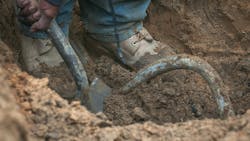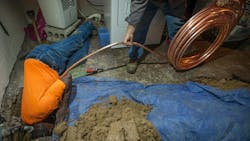Denver Water pulls out lead and pulls in copper water lines
Denver is an anomaly among big cities of the western United States. Its climate is semi-arid, yet it is fortunate to have access to an abundance of water from the surrounding Rockies. The challenge for Denver has been to store and convey water from rivers, streams and reservoirs on both sides of the Continental Divide to its growing urban population. Denver’s history is intertwined with Denver Water’s history. Major infrastructure projects such as the Cheesman Dam and the Moffat Water Tunnel shaped the history of the Mile High City.
Trouble in the water
Yet today, Denver is faced with another kind infrastructure problem. It has a lead problem. The United States Environmental Protection Agency (EPA), along with medical toxicology professionals, have asserted that there is no “safe level” of lead in drinking water.
Unfortunately, tens of thousands of older homes in Denver use lead service lines to connect with the water main. Denver was founded in the 19th century and has grown steadily as railroads connected the east with the west. Service lines from that era were commonly made from lead pipes. Lead was cheap, and easy to work with and health hazards associated with lead were not well known. Growing concerns about the toxicity of lead were raised after WWII, but it was not until 1986 that the installation of new lead service lines was banned by an Act of Congress. And yet, the existing lead service lines continue to be used to this day. Denver Water estimates that 64,000 to 84,000 properties may have lead service lines in its service area. Homes built before 1951 are especially likely to contain lead pipes in their service lines. The number of homes likely to have lead service lines in Denver is vast. The cost to replace all the lines could potentially be hundreds of millions of dollars. Legally, the service lines are the responsibility of the property owner. However, since lead in drinking water is health hazard, Denver Water aims to replace all the lead pipes at no direct cost to homeowners.
Denver water leads the way
The dividing point is between the main and the service line. It is where the water leaves the public system and enters privately-owned facilities to serve individual premises. The service line is owned by and installed at the expense of the property owner. Recognizing the hazards posed by lead in service lines, Denver Water agreed to replace any customer-owned lead service line that it discovers with a copper water line at no direct charge to the customer when discovered during pipe replacement projects. Furthermore, customers who have lead service lines that are not encountered during pipe replacement work will be enrolled in the Lead Reduction Program. As part of the program, Denver Water will replace customer-owned lead service lines with copper service lines at no direct charge to the customer.
Denver Water takes pride in being a national leader in the management of clean water systems, and its lead service line replacement program is no exception. It has launched a public information campaign with high-quality educational videos to inform its customers about the program. It has also mapped out all the properties identified as likely to have lead service lines. Denver residents can enter their address, and the map will tell them if their home is one of the estimated 64,000 to 84,000 homes with a possible lead service line.
Certain measures have also been taken to protect the health of those residents who are waiting for lead service line replacement. Residents have been provided with water filters and advised to filter any water used for drinking, cooking or food preparation. Another measure taken has been to increase the pH of the water in the mains, which helps to form a protective coating over any lead pipes in the system. Denver Water also established a laboratory to study the relation between pH levels and the amount of lead released from lead service lines. In this manner, lead levels can be kept at a minimum while homeowners await the installation of copper water lines. In addition, if property owners choose to replace their lead service line at their own expense, they may be eligible for a partial reimbursement of their total cost. A homeowner may be eligible to receive up to $3,800 toward the cost of lead service line replacement should they decide to do it at their own expense.
Prioritization
Realistically, as with many large cities across the United States, it will take 15 years to replace all the lead service lines. One might look at the 15- year program and wonder why it will take so long. Before the acceleration was implemented, Denver Water was replacing service lines at a rate of about 1,200 per year.
Initially, data on the number of existing lead service lines was unclear. Once the total numbers were realized, it was obvious that the pace was too slow. At the original pace, it might take 50 years or more to replace all the lines. The current program will replace about 5,000 lead service lines per year. That means that 60,000 service lines could be replaced in a dozen years or, practically speaking, Denver could be lead-free in just 15 years. Denver Water’s model for prioritization determines replacement areas based on several factors, including the likelihood that lead service lines are in a given area and how many properties in a given area are identified as either having or likely to have lead service lines. The identification of elevated blood lead levels can be a factor as well as the number of critical facilities (e.g., childcare facilities and schools) identified as likely to have lead service lines. The replacement work is also coordinated with other efforts to minimize or avoid multiple disruptions to the same community. Now with several years of experience in prioritization, the model used by Denver Water is of great interest to other communities seeking to provide the maximum health benefits as quickly as possible.
Digging, boring and pulling through
Denver Water uses copper pipe for replacement pipes because it is durable, reliable, and long-lasting. Denver Water has produced several excellent videos to inform its residents of the replacement program and what to expect once work begins. Especially informative is the video simply titled “How does Denver Water replace lead service lines,” which describes two pipe replacement methods: The first is the pull-through method, which involves passing a cable through the old lead service line to the water main, attaching the cable to the copper pipe and then using an excavator to pull the lead pipe and copper pipe through to the water meter.
Another pipe replacement method utilized is the directional boring technique. The lead pipe is left in place, and new hole is bored through the ground from the meter to the basement of the home or from the meter to the water main. Connections are then made. Both techniques avoid having to dig a trench for the length of the pipe resulting in cost savings. Roya Alkafaji, Manager of Healthy Communities, summarized the work of Denver Water in a blog for the Environmental Defense Fund as follows: “Denver Water has one of the most successful lead service line (LSL) replacement programs in the country. Since it began the program in 2020, the utility has replaced nearly 14,000 LSLs—prioritizing lines to buildings serving vulnerable populations, such as child-care facilities. Denver Water has also distributed over 102,000 filters to local residents. EPA should continue to support their innovative approach.”
For more details on the benefits of choosing copper over other materials and to discuss your project needs, please contact the Copper Development Association (CDA).
About the Author

Marcus Elmer
Marcus Elmer, director of tube and fittings with the Copper Development Association, is a seasoned professional with over 15 years of experience in the plumbing and mechanical industries. He leverages his expertise to identify and influence market trends for copper tube and fittings products, driving strategic programs encompassing technical research, codes and standards, advocacy, and education. With a unique perspective gained from his time as a project manager with commercial plumbing, mechanical, and refrigeration contractors, Elmer has a deep understanding of the industry. He holds a Master of Business Administration from Union University in Tennessee and a Bachelor of Science in Construction from the University of Wisconsin-Stout.


